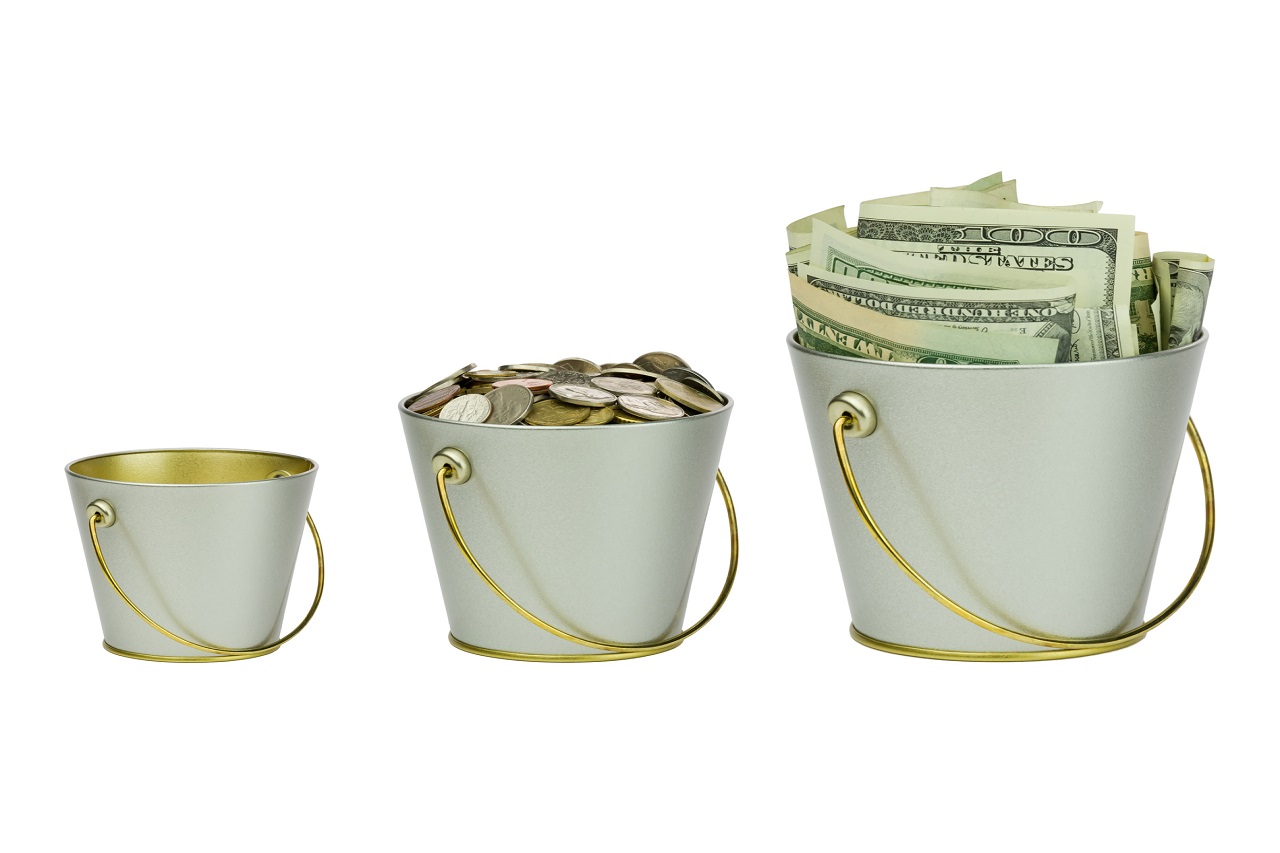How to Implement the Bucket System
This precautionary measure will help prevent you from making a catastrophic money move during a severe bear market.


Create a Bucket List
The 4% rule and its corollaries help ensure that your money will last through a 30-year retirement. The bucket system is extra insurance to help make sure you have enough until you kick the bucket.
Most people know that investing at regular intervals means you buy more shares when the market is low and fewer when the market is high. In retirement, you're making systematic withdrawals, which is the evil twin of dollar-cost averaging: You're selling more shares when the market is low and fewer when it's high. Each withdrawal exacerbates the decline when a fund falls in value and reduces the gains when the fund rises. In a severe bear market, pulling money from a tumbling fund can be catastrophic.
The bucket system is designed to keep you from doing just that. You divide your retirement money into three buckets: One is for cash that you'll need in the next year or two, including major expenses, such as a vacation, a car or a new roof. The next is for money you'll need in the next 10 years. The final bucket is for money you'll need in the more distant future, either for you or your heirs. The bucket system "gives you the confidence and peace of mind to stay the course," says Jason Smith, author of The Bucket Plan: Protecting and Growing Your Assets for a Worry-Free Retirement.
From just $107.88 $24.99 for Kiplinger Personal Finance
Become a smarter, better informed investor. Subscribe from just $107.88 $24.99, plus get up to 4 Special Issues

Sign up for Kiplinger’s Free Newsletters
Profit and prosper with the best of expert advice on investing, taxes, retirement, personal finance and more - straight to your e-mail.
Profit and prosper with the best of expert advice - straight to your e-mail.
Now, soon and later. The peace of mind comes from your first bucket -- the cash stash -- which you fall back on when markets get rough. For most investors, the cash bucket should be equal to one or two years' worth of what Smith calls the "income gap," or the difference between what you get from pensions and Social Security, and what you'll need to cover expenses.
Short-term interest rates are still lower than an ant's ankles. But think of your cash bucket as a hedge against a market decline. "When you take out fire insurance, you don't get upset when your house doesn’t burn down," says Harold Evensky, a certified financial planner and chairman of Evensky & Katz/Foldes Financial. "You're not trying to make money with this bucket," he says. "You're making sure it's there when you need it."
Your second bucket should be the one that throws off the most income. Conservative investors might prefer a portfolio of laddered bank CDs or bonds. Investors who can stand a little more risk might toss in some high-yield-bond or preferred-stock funds. Aggressive investors might also mix in equity-income funds, which focus on dividend-producing stocks.
If the first bucket is now and the second bucket is soon, the third bucket is later. It should contain higher-growth, long-term investments, including stocks and alternative investments, such as commodities, real estate, hedge funds and the like.
Separate accounts. As a practical matter, it helps to have a separate account for each bucket, says Mark Paccione, director of investment research at financial planning firm Captrust. "We monitor the split between the three buckets and, depending on what's going on in the market, opportunistically draw down from the income or growth bucket to replenish the cash bucket." Remember that there's a cost -- in taxes and transaction fees -- to fine-tuning your portfolio too often.
Given sizable bull market gains, it would make sense now to use the growth bucket as a source for replenishing the cash bucket, says Christine Benz, director of personal finance at Morningstar. "It's the logical place to harvest for the next couple of years or more," she says.
The test of the bucket system comes in years when gains are scarce. Evensky has been a believer for decades. "During the 1987 stock market crash, when it looked like the world was going to end, I was in the office by seven o'clock in the morning, and the phone didn't ring," he says. "I thought all my clients were dead or in the hospital." The reason they didn't call? "All my clients knew where the grocery money was coming from."
Funds to Fund Retirement
Managed payout funds guarantee a set monthly payout. But the amount you'll receive will change at regular intervals, usually annually. Typically, if a managed payout fund doesn't earn enough to make the monthly payout, part of your check will be a return of your capital.
Some funds aim to distribute all of your investment within a certain period, for example; others touch principal only when absolutely necessary. Vanguard's Managed Payout Fund aims for, but doesn't guarantee, a 4% annual distribution rate. Currently, if you invest $100,000, the fund will send you $295 a month. To try to smooth variations in payouts, T. Rowe Price bases its payout on a five-year average of the fund’s net asset value. Charles Schwab & Co., the American Funds, Fidelity Investments and J.P. Morgan also offer managed payout funds.
Most investors equate managed payout funds with immediate annuities. Managed payout funds can't guarantee a fixed income, but you can sell shares if you need to. Costs are typically lower than for annuities, too.
How to Fill Your Buckets
Here's a sample bucket portfolio for a couple with $500,000 in savings and a $20,000 gap between their income needs and money they receive from pension and Social Security payments. The right mix for you will depend on your circumstances and your risk tolerance. The funds in the second bucket all have yields of more than 3% and expense ratios below 0.5% -- in most cases, well below.
Bucket One: Cash
Amount: $20,000, or one year's income needs
Your basic choices are between money market funds and bank money market accounts. Money funds are mutual funds, and their yield depends entirely on their investments in Treasury bills, jumbo bank CDs and the like. The average yield is 1.6%, but you can get higher yields from funds with low expenses, such as Vanguard Prime Money Market (symbol VMMXX), currently charging 0.16% in expenses and yielding 2.1%. Banks compete among themselves for money market accounts, which, unlike money funds, are federally insured. At this writing, the top-yielding accounts pay about 2%.
Bucket Two: Conservative Income
Amount: $230,000
Weighted average yield: 4.0%
This diversified income portfolio offers inflation protection, international diversification and a very modest stock exposure.
Vanguard Core Bond Admiral (VCOBX)
Category: Intermediate-term bond
Allocation: $69,000, or 30%
Yield: 3.3%
Vanguard Short-Term Investment Grade Bond (VFSTX)
Category: Short-term bond
Allocation: $46,000, or 20%
Yield: 3.1%
Dodge & Cox Global Bond (DODLX)
Category: World bond
Allocation: $23,000, or 10%
Yield: 4.4%
iShares GNMA Bond ETF (GNMA)
Category: Intermediate government bond
Allocation: $23,000, or 10%
Yield: 3.1%
iShares U.S. Preferred Stock ETF (PFF)
Category: Preferred stock
Allocation: $23,000, or 10%
Yield: 5.7%
Schwab Treasury Inflation Protected Securities Index Fund (SWRSX)
Category: Inflation-protected bond
Allocation: $23,000, or 10%. Yield: 5.3%
Vanguard High-Yield Corporate Bond (VWEHX)
Category: High-yield bond
Allocation: $23,000, or 10%
Yield: 5.6%
Bucket Three: Long-Term Growth
Amount: $250,000
Annualized weighted five-year return: 10.4%.
It's best not to get overly fancy with a basic long-term stock portfolio. Stay diversified and keep expenses low.
Vanguard Total Stock Market Index Admiral (VTSAX)
Category: Large blend
Allocation: $150,000, or 60%
Expense ratio: 0.04%
Schwab International Index (SWISX)
Category: Foreign large blend
Allocation: $50,000, or 20%
Expense ratio: 0.06%
Fidelity Convertible Securities (FCVSX)
Category: Convertibles
Allocation: $25,000, or 10%
Expense ratio: 0.45%
Vanguard Equity-Income (VEIPX)
Category: Large value
Allocation: $25,000, or 10%
Expense ratio: 0.56%
Yields are as of August 8.
TAKE OUR QUIZ: Put Your Retirement IQ to the Test
Profit and prosper with the best of Kiplinger's advice on investing, taxes, retirement, personal finance and much more. Delivered daily. Enter your email in the box and click Sign Me Up.
